Setting Up a CCTV Control Room: What You Need To Know

It is common to find a CCTV room in or around office and apartment buildings. These special rooms play essential roles as the security and surveillance hub for any installation. Whether you are a security expert or a home or business owner looking to improve security, having a CCTV room can be an effective solution.
In this article, we will discuss things to keep in mind when setting up a CCTV control room, its equipment, and how it is run, among other things. By the end of this guide, you should have an idea of how to establish your CCTV room.
- What is a CCTV Control Room?
- Tips for Planning the CCTV Room’s Layout
- Equipment in a CCTV Control Room
- Standard Operating Procedures of a CCTV Control Room
- Daily Checklist When Operating a CCTV Control Room
- Duties and Responsibilities of Operators
- How to Design CCTV Control Rooms? Example Are Here
- FAQs
- Conclusion
What is a CCTV Control Room?
CCTV (closed-circuit television) is a system of video cameras whose signals are transmitted to a specific set of screens, primarily for surveillance and security purposes.
Therefore, the CCTV control room is where CCTV footage is monitored, and data is retrieved, analyzed, and processed. Usually the heart of a building’s security system, the CCTV control room is a hub where security personnel monitor and manage security systems and processes.
In today’s world, where we face several potential security threats, a CCTV control room can serve as a critical line of defense.
Tips for Planning the CCTV Room’s Layout
For efficient performance of a CCTV control room, all equipment should be well-organized and operate correctly. Therefore, adopting a sensible layout of the room is essential. You should keep the following in mind when planning the control room’s design:
Make your CCTV Control Room Sufficiently Spacious
It’s easy to underestimate how much space you need for your CCTV control room. To determine if your intended CCTV surveillance room is large enough, mark the floor or walls to note where your control consoles, chairs, video walls, and storage units will fit.
Remember to avoid having potential barriers such as pillars or poorly placed walls in your control room. These structural features may seem innocuous, but they could cause issues with line of sight and effective use of space.
Ensure the Room is Well-lit
Lighting is an often-forgotten factor in CCTV control room design that can make a massive difference for your operators. Overly bright lighting can cause eye fatigue, especially at night. At the same time, you need enough lighting for operators to use their equipment comfortably.
We recommend using multiple light sources designed for control centers to create consistent lighting throughout the room.
Keep the Space Distraction-free
CCTV control room operators must often concentrate on multiple tasks and systems simultaneously. This requires a distraction-free environment, so you need to consider noise and other interruptions and take action to insulate workstations from outside. If you haven’t built your control room, choose the right place; keep your control room far from major roads, railways, airports, or other busy areas.
Consider the Line of Sight
CCTV control rooms rely on operators to react and seamlessly work together quickly. Sometimes, operators may need to look at large monitors in other parts of the room. Every station needs clear lines of sight to essential screens and displays. You may want to avoid pillars and other blockages in your CCTV control room design that could obstruct the clear view.
Choose the Right Equipment for Your Operators’ Needs
As operators may have to sit in control rooms all day, you should try to make their workstations comfortable. When shopping for buying equipment, conduct research to choose the best options. Use adjustable, ergonomic equipment like chairs and consoles built to last. These will allow operators to work comfortably and with good posture.
Equipment in a CCTV Control Room
A CCTV control room will have various equipment depending on its size, your budget, and objective. Below are some devices you can expect to find in a CCTV room.
1. Control consoles
These pieces of equipment allow the operator to adjust the surveillance system’s functions, such as switching between video feeds and controlling and changing camera settings.
2. Storage units
After capturing footage, CCTV surveillance cameras transmit signals to the security camera recorders for saving and replaying key moments. NVRs and DVRs are often employed in CCTV camera systems for constant recording.
NVRs and DVRs can also be used for setting up home security systems. Reolink home security system products could be a great choice.
3. Displays
CCTV control rooms heavily benefit from a decent display system that shows all the videos captured by different cameras from distinct sources. Display systems like video walls are an excellent choice for control rooms wanting to condense many live cameras views into one area.
4. Workspace
Each operator works via a workstation to view real-time surveillance feed display. A basic workstation comprises a desk, a chair, and a monitor.
5. Alarm system
Alarm systems alert control room operators to events of interest in a surveilled area. Alarm monitoring in a CCTV control room allows personnel to respond to these alerts and take appropriate action quickly.
6. Communication equipment
Examples are headsets and intercom systems, allowing operators to communicate efficiently.
7. Network equipment
Equipment like routers, switches, and servers are usually used in CCTV systems. This equipment allows video feed to be transmitted and managed across a network.
8. Backup power
Power outages can compromise video surveillance, so a backup power source is required to keep the CCTV room functional when power is down.
Standard Operating Procedures of a CCTV Control Room
Establishing clear standard operating procedures can help control room operators perform their required roles in all situations. This can help to reduce confusion and increase the efficiency of the control room. Some standard operating procedures include:
1. Task assignment
Supervisory operators are in charge of this part. Surveillance areas are divided and assigned among operators to ensure they have designated areas to work on.
2. Access control
Access control systems allow businesses to restrict access to certain areas or facilities based on predetermined criteria.
This can include requiring individuals to present a valid identification card or passcode to gain access. After receiving this information, CCTV cameras with AI functions can automatically monitor and verify the identity of individuals seeking access.
3. Remote monitoring
This is the primary task of a CCTV room operator. Remote monitoring allows security personnel to monitor and respond to potential threats in their assigned area.
4. Alarm system monitoring
Alarm systems are used to alert security personnel to potential threats. Once alarms have been triggered, the operator should alert the necessary authorities.
5. Reports feedback
At the end of each day, operators should give detailed feedback on what happened during their shifts. They can provide a written or oral report to their supervisors.
Daily Checklist When Operating a CCTV Control Room
After the equipment is set up, it must be checked daily to ensure it is functional for work. Below is a guide on things to inspect in a CCTV room’s equipment:
Camera Checklist
The daily checklist about cameras may include the following:
- Checking if the cameras’ lenses are focused and adjusted correctly.
- Checking for stains and smudges on camera lenses.
- Checking if the motion detection sensors are working properly.
- Checking if camera functions like pan, zoom & tilt are working correctly.
- Checking for obstructions in the camera view.
Storage Capacity Checklist - Ensuring surveillance footage is stored correctly and accessible.
- Checking for sufficient storage space on the storage device.
- Checking for repairs on storage devices
Wire and Cable Checklist
To ensure all equipment has a stable Internet connection, wires and cables should be checked too.
- Ensuring cables are in good condition and connected correctly.
- Checking for exposed wires of equipment.
Control Equipment Checklist
Apart from the things mentioned above, control equipment, for example, display devices, monitors, and other equipment, need routine checks too, like these questions:
- Confirming the displays, monitors, and other equipment are fully functional.
- Ensuring footage is visible.
- Adjusting the brightness and contrast settings of displays and monitors.
- Ensuring the time and date stamp are correctly set.
Duties and Responsibilities of Operators
Once you’ve set up the CCTV room, you may need operators to handle daily operating procedures. And their dusties and responsibilities include the following:
1. Observing surveillance footage
This involves sitting in front of a bank of several screens, constantly monitoring the live footage coming from the surveillance cameras.
2. Operation of cameras
This involves adjusting camera settings and the occasional camera inspection to ensure they work smoothly.
3. Use of security software
Security software can help security personnel more efficiently monitor and manage the security systems. This can include software for managing CCTV cameras, access control systems, and alarm systems.
4. Alert emergency responders
Operators will also be responsible for alerting authorities like the police or fire station as the situation may require.
How to Design CCTV Control Rooms? Example Are Here
Below are picture examples of CCTV room layouts to help you visualize them better.
Statement: We download all the pictures below from Internet. If the usage of these pictures infringe your copyright, please contact us. We will remove them from our post as soon as possible.
Example 1: Basic layout of a CCTV control room
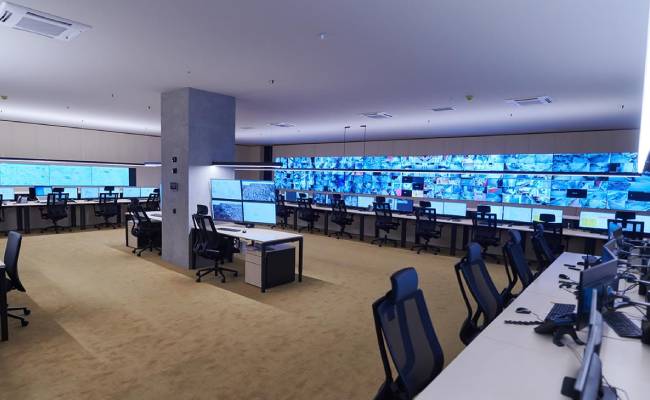
Basic Layout By Russbassett
A spacious CCTV control room with different screen displays and individual workstations for operators.
Example 2: Professional CCTV control room
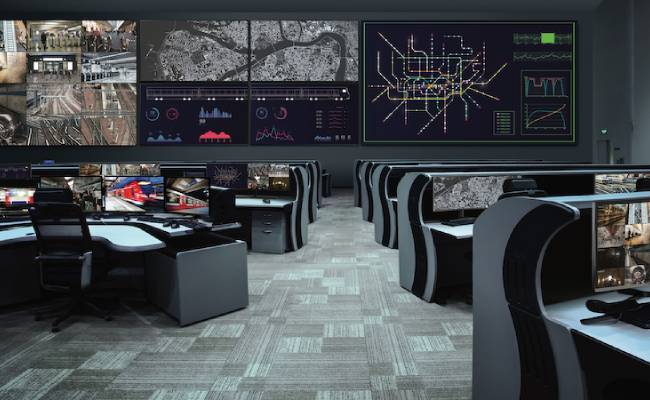
Professional CCTV Control Room By Insights
This photo shows the setting up of a more professional CCTV control room. A large video wall is placed in front of the room where operators can watch live views from surveillance cameras.
Example 3: Display screen
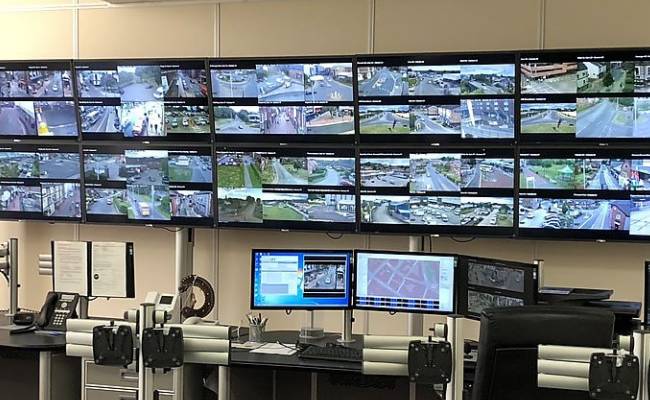
Display Details By WREXHAM
This is what the display equipment of a CCTV control room looks like; different screens are arranged to form a video wall, with each screen displaying footage from more than one camera.
Example 4: Operator position
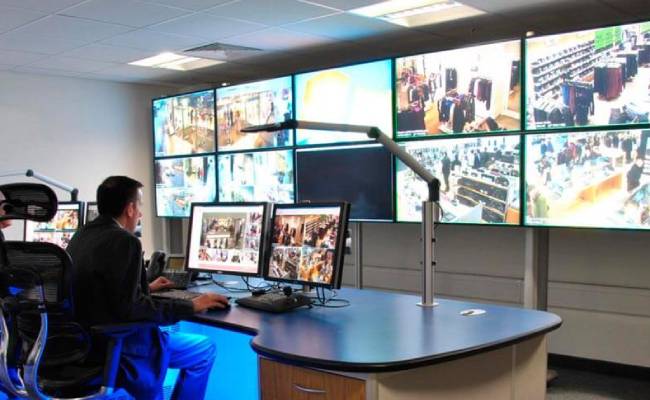
Operator Position By Evolution Media Walls
Operators usually sit in front of display screens, carefully observing footage.
Example 5: Emergency response
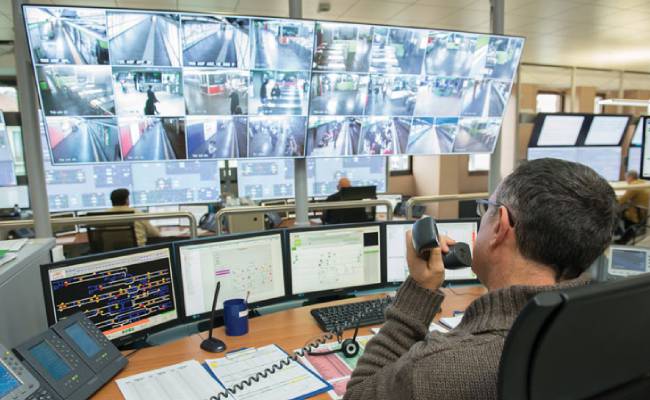
Actions of Alarm Control By Intelligent Transport
When a potential threat or suspicious person is detected, operators inside the control room will alert the appropriate responders.
Example 6: Ventilation Systems - Air Flow Design
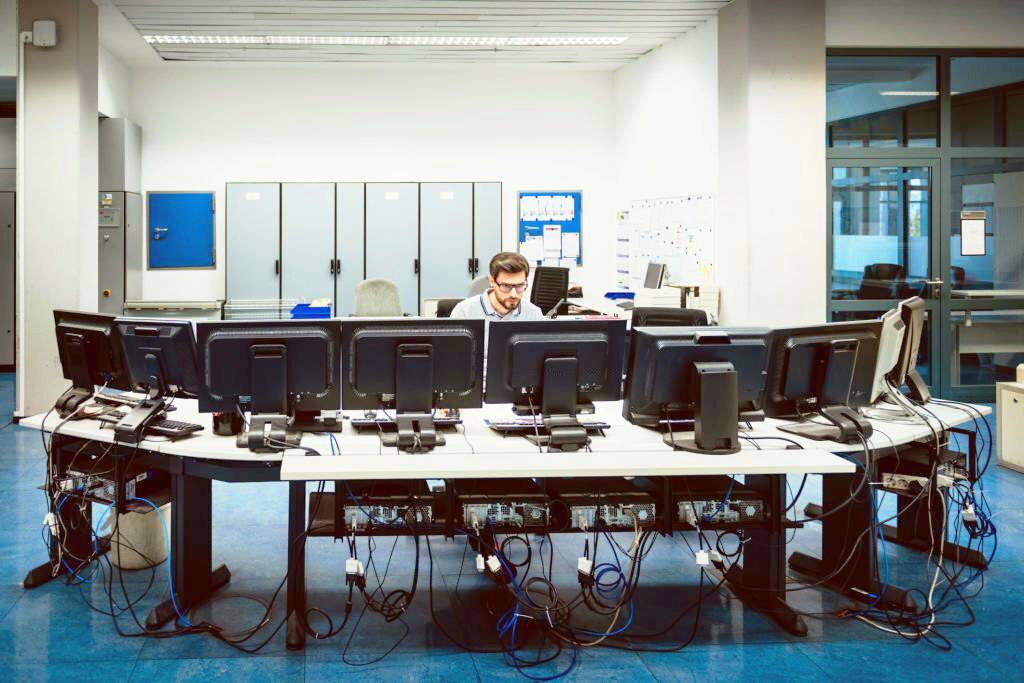
Air Flow Systems By Control Room Consoles
A CCTV control room needs good ventilation to keep operators comfortable and prevent equipment from overheating. The photo shows a specialized ventilation system for control rooms.
FAQs
What Is the Purpose of Setting Up a CCTV Control Room?
A CCTV control room is usually a central hub within a facility or organization where security personnel control and monitor security systems and processes. Setting them up mainly aims to monitor activities occurring inside a building and protect people and businesses from potential threats.
What Equipment Should Be Inside a CCTV Control Room?
Essential equipment for a CCTV control room includes video storage devices, workstations, access control systems, alarm systems, and other security technologies.
What Is the Standard Size of a CCTV Control Room?
There is no standard size for a CCTV control room. Several factors can affect the size, such as the requirements of the surveillance system and the number of operators. You just have to ensure the location is spacious enough for your setup.
How Do You Organize Different Areas of the CCTV Control Room?
Like every working space, the CCTV room can be organized into distinct areas, depending on available space. This would allow the room to function as smoothly as possible. Examples of the room’s sections are the viewing area, communication area, control area, etc.
Conclusion
Establishing a CCTV control room requires good planning and consideration of several factors. Operators, too, are essential, as they ensure the control room works as efficiently as possible.
If you want to keep watch over an area, you can’t go wrong with a CCTV control room, whether an amateur or a security expert. Hopefully, this guide has given you basic knowledge of the workings of the surveillance room.
If you have any questions or suggestions, don’t hesitate to share your ideas with us in the comment section below!
Search
Subscribe for the Latest Updates
Security insights & offers right into your inbox
